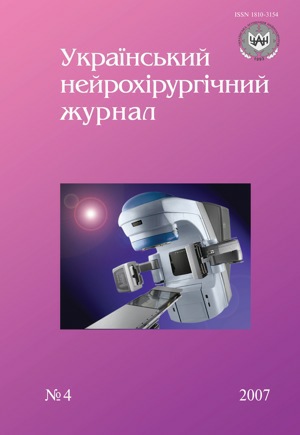Application of epidural electrostimulation method at patients after spinal cord injury in thoracal and lumbar segments
DOI:
https://doi.org/10.25305/unj.112330Keywords:
спинний мозок, травма, епідуральна електростимуляція.Abstract
The results of spinal cord epidural electrostimulation at 45 patients with the consequences of spinal cord injury in thoracal and lumbar segments are presented. Only the patients with chronical spinal cord injury were included in the research. We made an estimation of movement’s restoration according ASIA scale. 16 patients had the thoracal segments injury, 28 — lumbar segments, 1 — the consequences of cauda equine’s injury. The results of spinal cord epidural electrostimulation depended from injury’s severity and the zone of the electrodes application, 92,8% of patients from Frankel’s group B and all patients from group C performed the movements’ restoration in their legs. 15,7% of patients from Frankel’s group A had the restoration of movements’ in their legs on (9,7±1,2) points according to ASIA. Epidural electrostimulation of spinal cord lumbar segments gave better results at patients with the consequences of thoracal segments injury.
The spinal cord epidural electrostimulation is effective method for movement’s restoration after particular spinal cord injury.References
Поліщук М.Є. Травматичне ушкодження спинного мозку. — К.: Книга-плюс, 2004. — 264 с.
Цимбалюк В.І., Чеботарьова Л.Л., Ямінський Ю.Я. Трансплантація ембріональної нервової тканини як метод відновлення функцій спинного мозку після травми в експерименті// Укр. нейрохірург. журн. — 2002. — №1. — С.69–76.
Barolat G., Massaro F., He J. et al. Mapping of sensory responses to epidural stimulation of the intraspinal neural structures in man // J. Neurosurg. — 1993. — V.78. — P.233–239.
Guest J.D., Rao A., Olson O., Bunge M.B. The ability of human Schwann cell grafts to promote regeneration in the transected nude rat spinal cord // Exp. Neurol. — 1997. — V.148. — P.502–522.
Hill C.E., Beattie M.S., Bresnahan J.C. Degeneration and sprouting of identified descending supraspinal axons after contusive spinal cord injury in the rat // Exp. Neurol. — 2001. — V.171, N1. — Р.153–169.
Itoh Y., Mizoi K., Tessler A. Embrionic central nervous system transplants mediate adult dorsal root regeneration into host spinal cord // Neurosurgery. — 1999. — V.45, N.4. — Р.848–855.
Jonson M. R., Tomes D..J., Trevers J.S. et al. Minimaly invasive implantation of epidural spinal cord neurostimulator electrodes by using a tubular retractor system // J. Neurosurg. — 2004. — V.100. — P.1119–1121.
Kanpolat Y., Cosman E. Special radiofrequency electrode system for computed tomography-guided pain-relieving procedures // Neurosurgery. — 1996. — V.38. — P.600–603.
Kim S.H., Tasker R.R., Oh M.Y. Spinal cord stimulation for nonspecific limb pain versus neuropathic pain and spontaneous versus evoked pain // Neurosurgery. — 2001. — V.48. — P.1056–1065.
Krishnan R.V., Muthusamy R., Sankar V. Spinal cord injury repair research: a new combination treatment strategy // Int. J. Neurosci. — 2001. — V.108. — P.201–207.
Kumar K., Malik S., Demeria D. Treatment of chronic pain with spinal cord stimulation versus alternative therapies: Cost-effectiveness analysis // Neurosurgery. — 2002. — V.51. — P.106–116.
Lu J., Feron F., Mackay-Sim A., Waite P.M. Olfactory ensheathing cells promote locomotor recovery after delayed transplantation into transected spinal cord // Brain. — 2002. — V.125. — P.2–3.
McCaig C.D., Sagster L., Stewart R. Neurotrophins enhance electric field-directed growth cone guidance and directed nerve branching // Dev. Dyn. — 2000. — V.217. — P.299–308.
North R.B., Kidd D.H., Olin J.C., Sieracki J.M. Spinal cord stimulation electrode design: prospective, randomized, controlled trial comparing percutaneous and laminectomy electrodes — Part I: Technical outcomes // Neurosurgery. — 2002. — V.51. — P.381–390.
Oakley J.C., Prager J.P. Spinal cord stimulation: mechanisms of action // Spine. — 2002. — V.27, N22. — P.2574–2583.
Ramon-Cueto A., Cordero M.I., Santos-Benito F.F., Avila J. Functional recovery of paraplegic rats and motor axon regeneration in their spinal cord by olfactory ensheanthing glia // Neuron. — 2000. — V.25. — P.425–435.
Rijkhoff N.J., Wijkstra H., Van Kerrebroeck, P.E., Debruyne F.M. Selective detrusor activation by electrical sacral nerve root stimulation in spinal cord injury // J. Urol. — 1997. — V.157. — P.1504–1508.
Shapiro S., Borgens R., Pascuzzi R., et al. Oscillating field stimulation for complete spinal cord injury in humans: a Phase 1 trial // J. Neurosurg. Spine. — 2005. — V.2. — P.3–10.
Tator C.H. Biology of neurological recovery and functional restoration after spinal cord injury // Neurosurgery. — 2000. — V.42. — P.696–708.
Woerly S., Doan V.D., Evans-Martin F. et al. Spinal cord reconstruction using NeuroGel implants and functional recovery after chronic injury // J. Neurosci. Res. — 2001. — V.15, N66. — P.1187–1197.
Zurita M., Vaquero J., Oya S., Morales C. Effects of dexamethasone on apoptosis-related cell death after spinal cord injury // J. Neurosurg. — 2002. — V.96. — P.83–89.
Downloads
Published
How to Cite
Issue
Section
License
Copyright (c) 2007 V. I. Tsimbalyuk, Yu. Ya. Yaminsky

This work is licensed under a Creative Commons Attribution 4.0 International License.
Ukrainian Neurosurgical Journal abides by the CREATIVE COMMONS copyright rights and permissions for open access journals.
Authors, who are published in this Journal, agree to the following conditions:
1. The authors reserve the right to authorship of the work and pass the first publication right of this work to the Journal under the terms of Creative Commons Attribution License, which allows others to freely distribute the published research with the obligatory reference to the authors of the original work and the first publication of the work in this Journal.
2. The authors have the right to conclude separate supplement agreements that relate to non-exclusive work distribution in the form of which it has been published by the Journal (for example, to upload the work to the online storage of the Journal or publish it as part of a monograph), provided that the reference to the first publication of the work in this Journal is included.









